
Base price: $25.
2 – 4 players.
Play time: 10 – 25 minutes.
BGG Link
Buy on Amazon (via What’s Eric Playing?)
Logged plays: 3
Full disclosure: A review copy of Castle Combo was provided by Pandasaurus Games.
I’m out of town (again) for a wedding (again) so this is being written from someone else’s couch (again). June is, near-perennially, wedding season, though I think I’m starting to age out of First Weddings and into Second Weddings / Late Weddings. No comment on my current marital status; you’re not reading these reviews to learn more about me (hopefully). We had a very lovely Sangeet ceremony tonight, so I’m relatively tired. Managed to confuse a bartender with my standard beer-and-wine-only-bar drink request, the kalimotxo. I think people think I’m nuts, but I swear to you, reader: it’s quite good. Anyways, I’m back now and writing again, so let’s check out another game: Castle Combo!
In Castle Combo, players vie to create the perfect tableau, with cards comboing off of each other left and right. Rows matter, columns matter, the cards present matter, the cards not present matter, money matters, keys matter: it all matters! Depending on what cards you take, at least. Each of the unique cards can change things up if you get what you needand manage to combine it with something else you need. However, any card you want might work better with your opponent’s strategy, so be careful! Will your castle have the best combo?
Contents
Setup
Not a ton. Set out the keys and coins. Each player gets two keys and 15 gold:
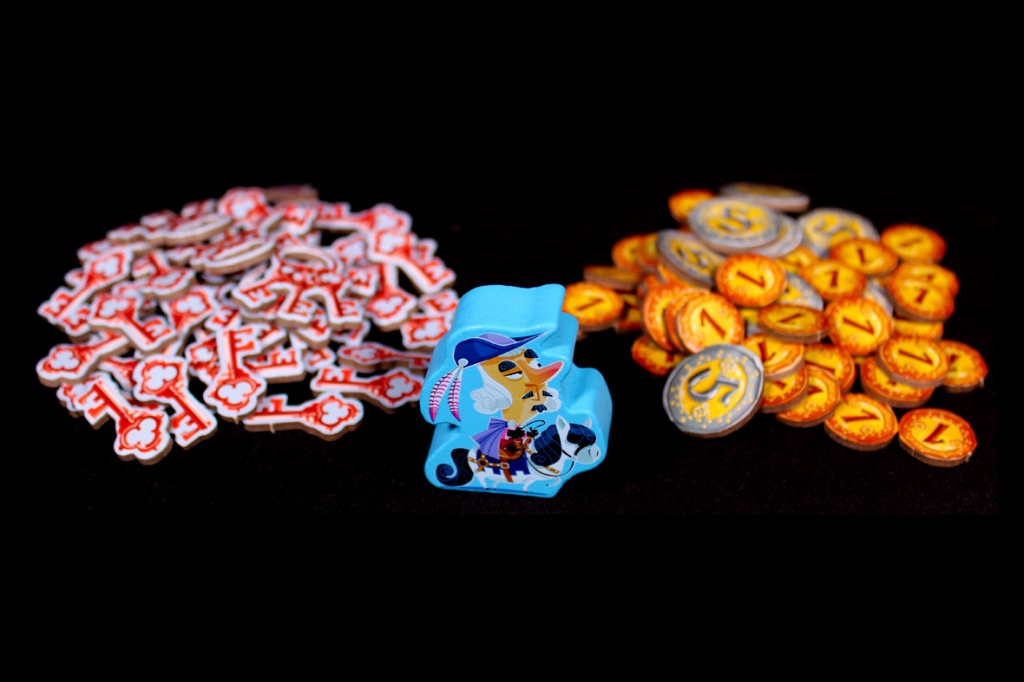
Shuffle the Castle cards and make a row of three cards and the deck:
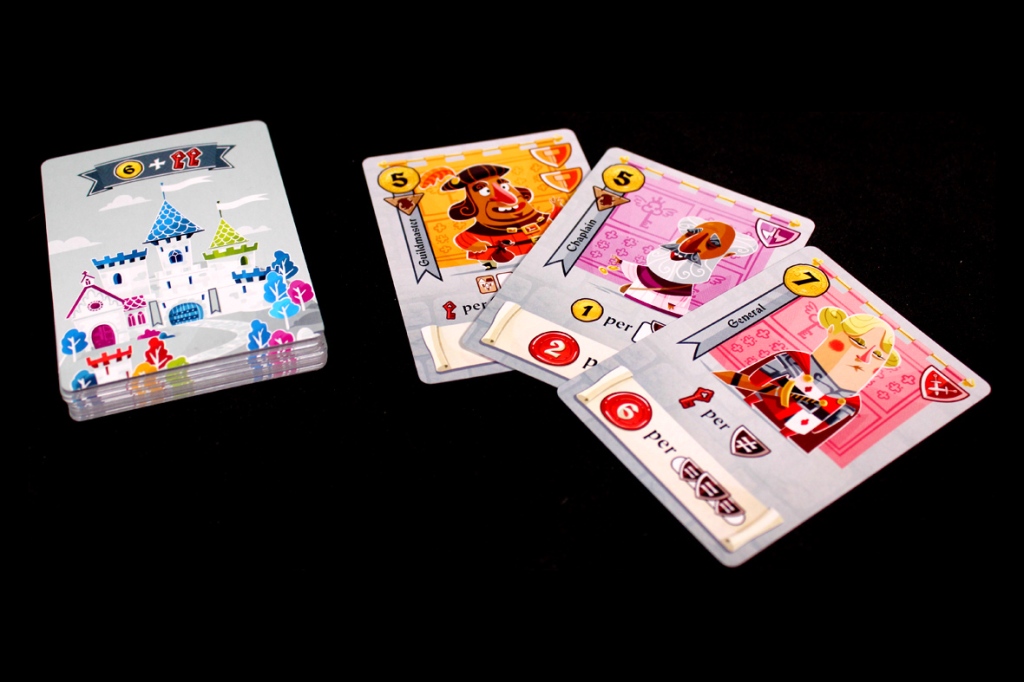
Shuffle the Village cards and make a row of three cards below the Castle row:
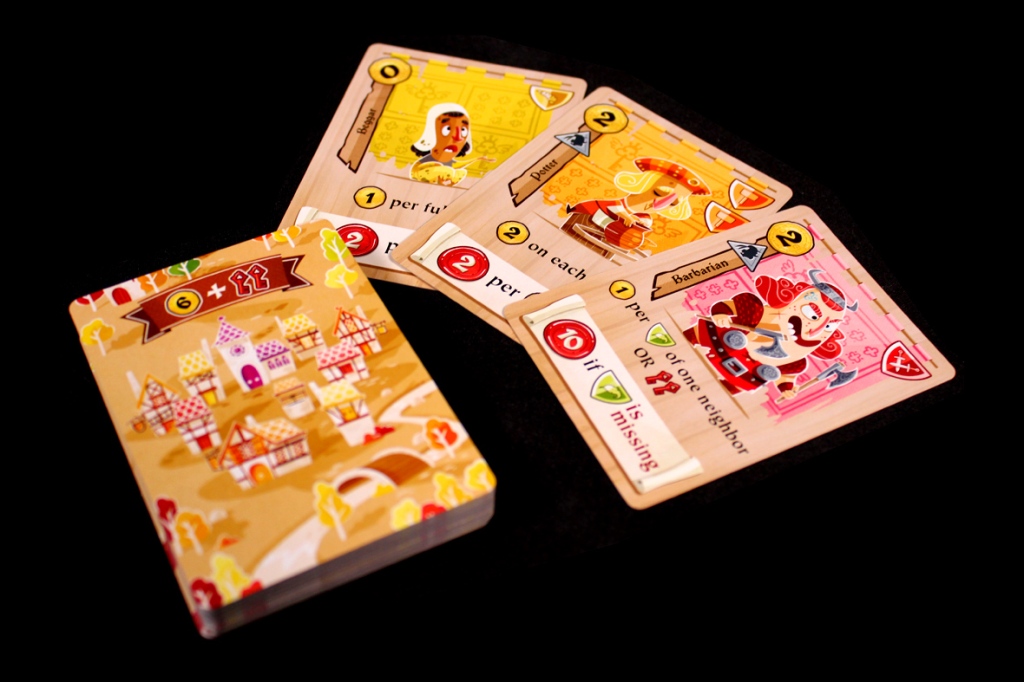
Place the Messenger Pawn next to the Village row. You should be ready to start!
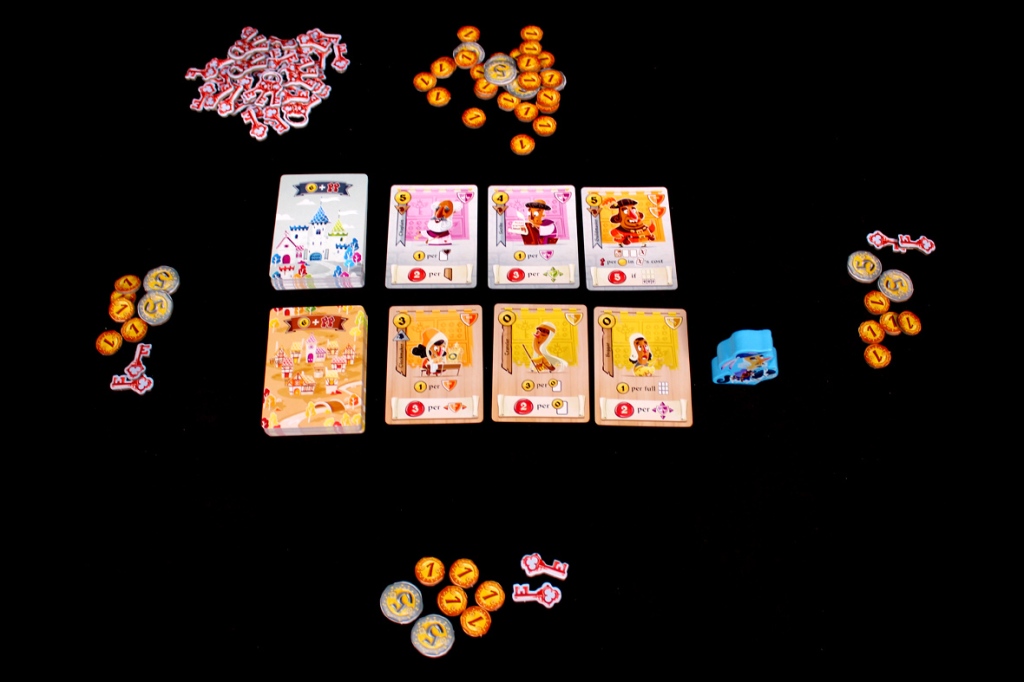
Gameplay
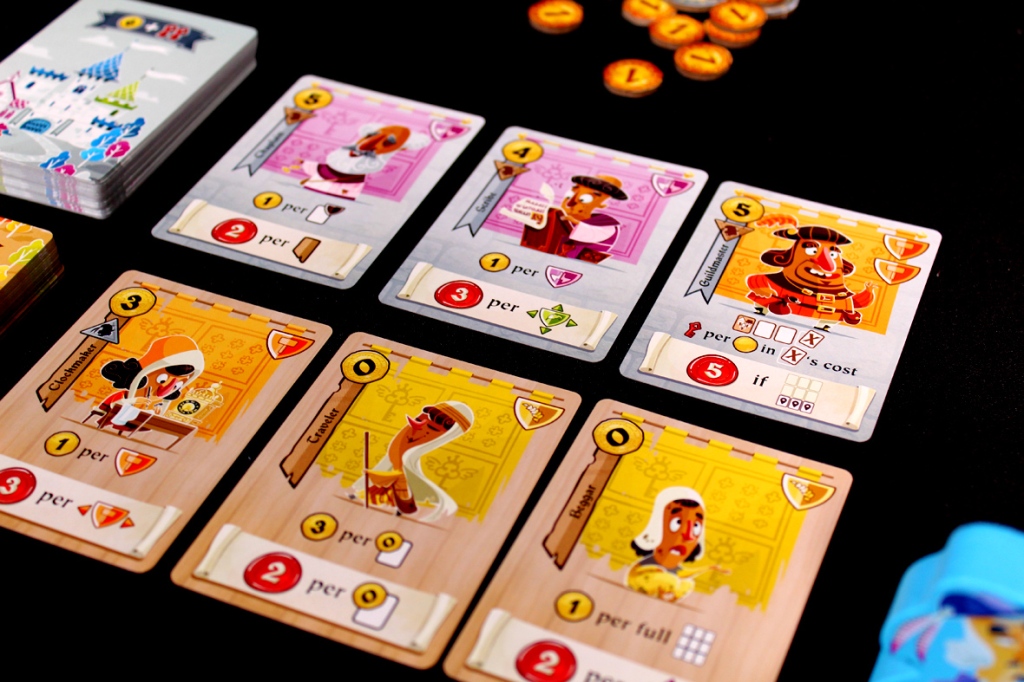
This one’s actually unbelievably easy to play, but winning is far more complicated. See, each turn you just take a card until you’ve taken nine cards, and that’s the game.
More specifically, you’ll draft a card from the row with the Messenger Pawn. You can take any of the three cards, no problem, and immediately place the card you took into your tableau. Some cards might indicate that you need to then move the Messenger Pawn to the other row. If you don’t like your card options, you can spend one key to:
- Discard all cards in the current row and refresh them.
- Move the Messenger Pawn to the other row.
Critically, you cannot do both. Choose wisely! When you choose a card, it must be either the first card you play or played adjacent to another card in your tableau, with one limit: you must have a 3×3 grid by the end of the game, and you cannot move cards once you’ve placed them, This means that if you place three cards in a row or in a column, that boundary of your tableau is now defined pretty robustly. Be mindful!
After you take and play a card, you’ll usually collect money based on some condition on the card. The other condition on the card will award points later in the game. Some cards offer discounts or keys instead; they’re all different. Use the icon references to figure out what’s what in the game.

Once all players have taken and placed nine cards, the game ends. Score each of the cards in your tableau and add one point for each key you have. The player with the most points wins!
Player Count Differences

I wouldn’t say many, since it’s another drafting game, but the double-row draft changes things a bit by causing a weird skip effect, here. Generally, the Messenger Pawn tends to bounce from one row to another every turn. This usefully means that in a three player game, you’d get Castle, P2 gets Village, P3 gets Castle, and you get Village next round (ideally; your exact cadence may vary). This also means with an even number of players, you get a symmetrical bouncing effect so you tend to stay in one place (again, this is relative; you may not see a lot of cards that change the Messenger Pawn’s location or you may even just not take them). Given that this has a very imprecise chance of happening based on player count, I can’t say I have a strong preference; it’s just something to watch out for no matter how many players you’re playing with.
Strategy
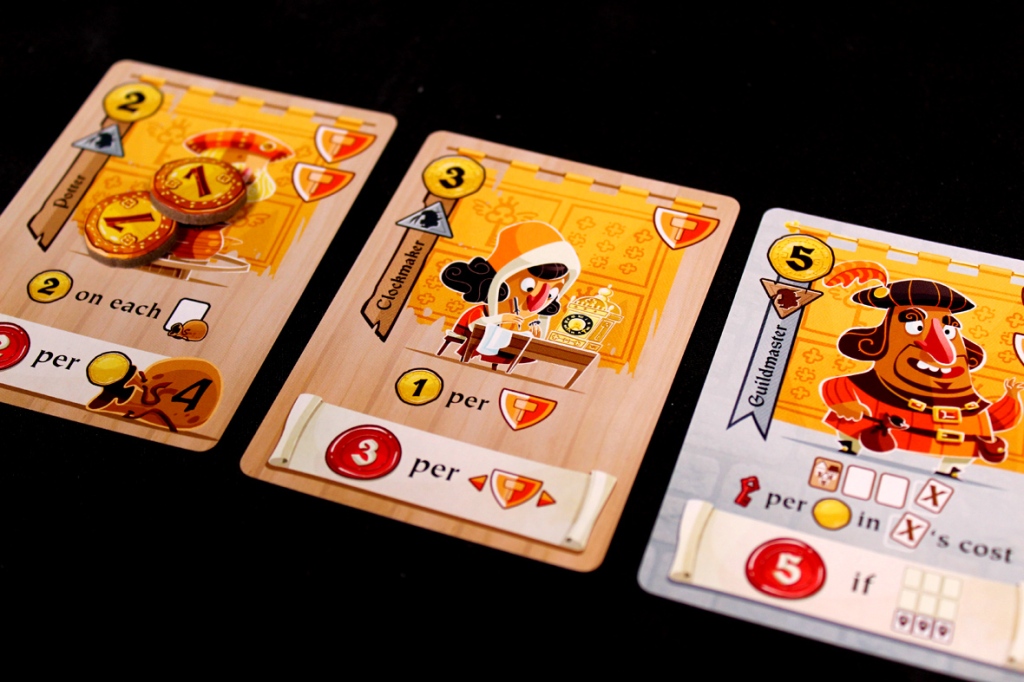
- The name of the game is quite literally combos. Your whole thing is going to be figuring out how you can get your cards to layer their scoring conditions to make for big swings. If you miss out on that, you’re done.
- If not combos, then synergies. Some cards naturally boost other cards by providing things they need, like keys for cards that score keys or cards that put coins on other cards’ purses. These support cards may not earn you a ton of points, but they can set up other cards to swing bigger and score bigger.
- You can see what other players need and try to mess them up, if you want, but that rarely helps you. I wouldn’t, unless you’re playing a two-player game, but even then, there are a ton of unique cards with their own combos and synergies. Unless you’re sure this is the exact card they need and they can’t find a useful equivalent, I wouldn’t bother. Focus on building yourself up instead of tearing other people down.
- I generally recommend not going for 0 on keys. Having at least one key is vital to make sure you can avoid a situation where you have to take cards you don’t want, and plenty of cards give you keys.
- Similarly, don’t take a face-down card. That sucks. It can give you money and keys, but it won’t give you anything in terms of points, and, well, you need points. It’s better than nothing, but not by a lot.
- Discounts are pretty handy! Cards are, generally, not that expensive, but money can be fairly tight. Cards that give you discount on other cards are another useful synergy, especially if you can stack them to get cards almost for free. Just don’t overindex on this! You need to score points, too.
Pros, Mehs, and Cons

Pros
- The card art is nice and whimsical! It’s very silly, which is always nice.
- This is an incredibly easy game to pick up and play, and I love that. You really just shuffle up two decks and then take turns taking a card and adding it to a grid. Once you’ve played it once or twice you’ve really got a senes of the core rules, and then the actual scoring adds a bit more to that complexity to make it interesting.
- The scoresheet layout makes sense and makes the game much easier to score than you’d think it would be. Thankfully. I always worry that it’s going to be a bad scoresheet that demands you score each row or something obtuse. Instead, it’s just “each card scores and you write that down and then sum it up”. It also helps that card scoring doesn’t really depend on any other card’s scoring (looking at that Fantasy Realms card that copies another card and gives you a headache in the process).
- Plays pretty quickly. Once you get really good, you can probably burn through a 2P game in ten minutes?
- Not too bad on portability, either. It’s not the smallest box (you can blame the keys and the coins), but it’s pretty portable. It’s nice!
Mehs
- You gotta make sure you’re paying attention to all of your cards, otherwise you’ll end up goofing yourself. It’s the cards that specifically reward you for not having a certain symbol that set you up for failure and then cards with two different symbols that seal your fate. It’s a perfect storm of an anti-combo, so be mindful of that.
Cons
- The iconography is not particularly intuitive! I made tons of mistakes in my first game. This is the hazard of icons versus text. You save on things like translation and some graphic design costs, but the game is harder to learn. The hazard here is that the icons look more intuitive than they are, so you run the risk that players won’t necessarily check the rulebook and will just assume that they’re right. Read all the icon guides.
Overall: 7 / 10
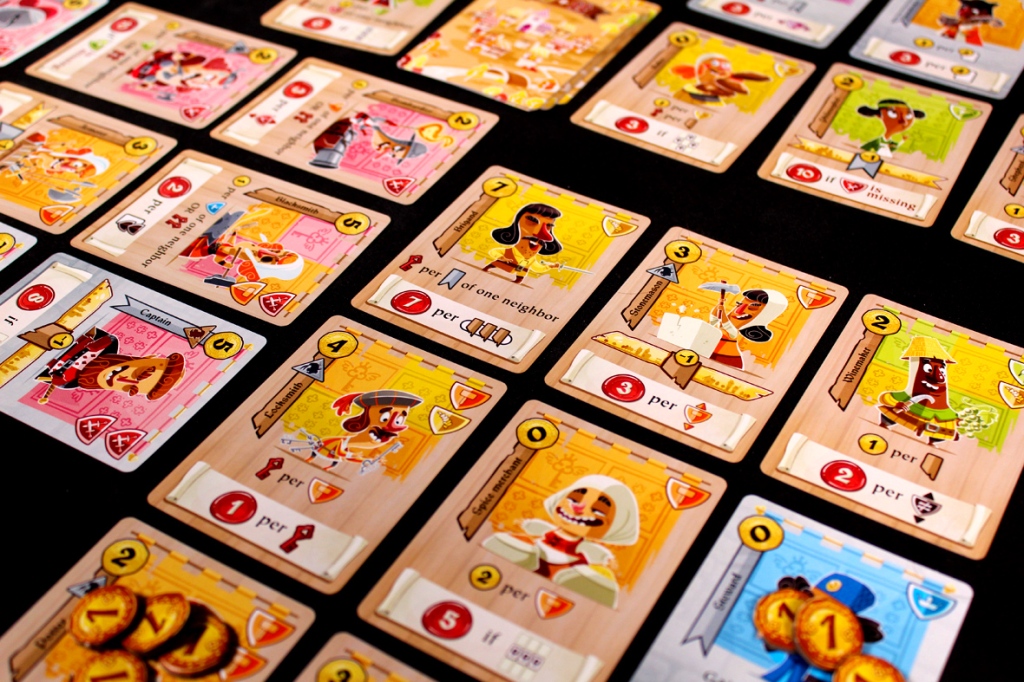
Overall, I like Castle Combo! I’d be hard-pressed to say that it blew me away, so, I mean, I was surprised by the whole Spiel des Jahres thing, but hey, to each their own. I do like it at its core: it’s a very pleasant drafting game that offers players a lot of interesting and unique options to build up a combo over the course of the game. I do think the icons could be more intuitive; I found myself thinking that icons that looked like “adjacent” meant adjacent when they meant, more frequently, “in this row” or “in this column”, which is fairly different. Found that frustrating once I figured it out. It is more interactive than you’d expect, as well: several cards directly depend on other players’ tableaus, which can be both fun and strategy-impacting, depending on how you swing it. Beyond that, though, it hits the “card game” itch for me, but doesn’t really vault past that into my favorite games. And that’s okay! I think the mathier, crunchier gamers will enjoy showing this to their families and friends, and I do think that watching players get the emergent strategy of all your cards mattering is a lot of fun. It reminds me of a more grid-based Fantasy Realms, which is a game I enjoy quite a bit. If you’re looking for grids, you want something easy to pick up and play, or you really vibe with the art style, Castle Combo is a fun title! Worth checking out.
If you enjoyed this review and would like to support What’s Eric Playing? in the future, please check out my Patreon. Thanks for reading!